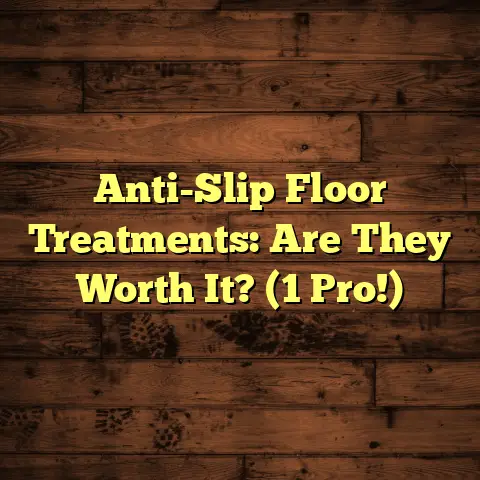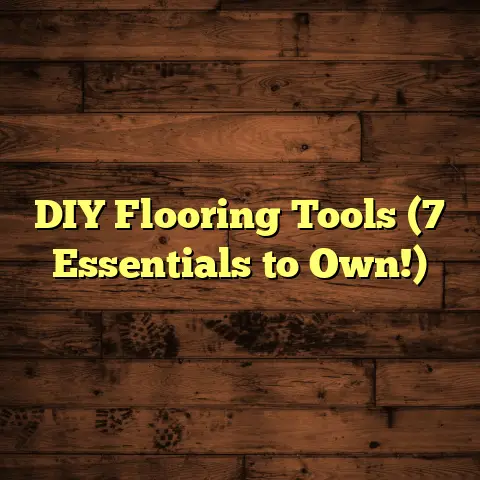Fix Upstairs Squeaky Floors! (2 Quiet Secrets!)
Are you tired of your upstairs floors sounding like a haunted house with every step you take?
I get it. For years, I’ve heard homeowners say, “Squeaky floors are just part of owning a home.”
That’s simply not true! You don’t have to live with those annoying creaks and groans.
I’m here to tell you that there are effective, practical solutions to silence those squeaks.
Let’s dive into the real reasons why your floors are making noise and, more importantly, how to fix them.
Section 1: Understanding the Causes
of Squeaky Floors
1.1. The Anatomy of a Floor
Think of your upper floors as a layered cake. You’ve got the joists, the subfloor, and the finished flooring, all working together.
-
Joists: These are the horizontal beams
that provide the main support for your floor.
They’re like the bones of your floor structure. -
Subfloor: This is the layer directly on
top of the joists. It’s usually made of plywood
or OSB (oriented strand board). Think of it as
the structural base for your finished floor. -
Finished Flooring: This is what you see
and walk on – hardwood, laminate, carpet,
tile, etc. It’s the decorative layer.
When these layers are properly connected, everything is solid and quiet.
However, when things start to loosen or rub against each other, that’s when the squeaks begin.
1.2. Common Causes of Squeaking
So, what makes a floor squeak in the first place? It’s usually one of these culprits:
-
Loose Floorboards: Over time, the nails
or screws holding your floorboards down can
loosen. This allows the boards to move and
rub against each other or the subfloor. -
Worn-Out Nails: Nails can lose their
grip, especially in older homes. They might
bend, rust, or simply pull out slightly,
creating space for movement. -
Movement Between Subfloor and Joists:
This is a big one. If the subfloor isn’t
securely fastened to the joists, it can rub
against them, causing a loud squeak. -
Environmental Factors: Temperature and
humidity play a huge role. Wood expands and
contracts with changes in moisture. This
movement can loosen fasteners and create gaps.- A study by the Forest Products Laboratory
found that wood can expand and contract
significantly with changes in humidity,
leading to increased stress on fasteners.
(Source: USDA Forest Service)
- A study by the Forest Products Laboratory
I’ve seen cases where a simple change in season caused floors to suddenly become much noisier.
Section 2: Secret #1 – The Power
of Lubrication
2.1. The Concept of Lubrication
Think of lubrication as putting oil on a rusty hinge. It reduces friction and allows things to move smoothly and quietly.
The same principle applies to squeaky floors. By applying a lubricant, you can reduce the friction between the moving parts that are causing the noise.
This is often the easiest and least invasive solution, especially for minor squeaks.
2.2. Types of Lubricants
There are several types of lubricants you can use, each with its own pros and cons:
-
Graphite Powder: This is a classic choice.
Graphite is a dry lubricant that’s excellent
for getting into tight spaces. It’s especially
good for hardwood floors.- Pros: Long-lasting, doesn’t attract
dust, good for small gaps. - Cons: Can be messy, might stain light
carpets or rugs.
- Pros: Long-lasting, doesn’t attract
-
Talcum Powder: Similar to graphite,
talcum powder is a fine powder that can reduce
friction. It’s a good option if you’re
concerned about staining.- Pros: Inexpensive, readily available,
less messy than graphite. - Cons: Doesn’t last as long as graphite,
can clump up in damp conditions.
- Pros: Inexpensive, readily available,
-
Silicone Spray: This is a versatile
option that works well for a variety of
flooring types. It’s a wet lubricant that
penetrates easily.- Pros: Easy to apply, good for larger
gaps, water-resistant. - Cons: Can attract dust, may need
reapplication over time.
- Pros: Easy to apply, good for larger
When choosing a lubricant, consider the type of flooring you have. For example, I wouldn’t use a wet lubricant like silicone spray on unfinished wood, as it could stain.
2.3. Application Techniques
Okay, let’s get down to how to actually apply these lubricants. Here’s a step-by-step guide:
-
Identify the Squeaky Areas: Walk around
the room and pinpoint exactly where the
squeaks are coming from. Mark these spots
with painter’s tape. -
Prepare the Area: Clean the area around
the squeak to remove any dirt or debris.
This will help the lubricant penetrate better. -
Apply the Lubricant:
-
Graphite or Talcum Powder: Use a small
squeeze bottle or a powder duster to apply
the powder into the gaps between the
floorboards. You can also use a paintbrush
to work the powder in. -
Silicone Spray: Insert the nozzle of
the spray can into the gaps and apply a
short burst of spray. Be careful not to
overdo it, as too much spray can make the
area slippery.
-
-
Work It In: After applying the lubricant,
walk over the area to help it work its way
into the gaps. -
Wipe Away Excess: Use a clean cloth to
wipe away any excess lubricant from the
surface of the floor.
I’ve found that using a small, flexible nozzle on the lubricant applicator is key to getting the product exactly where it needs to go.
Section 3: Secret #2 – Reinforcing
Joists and Subflooring
3.1. The Importance of Structural Integrity
Sometimes, lubrication just isn’t enough. If the squeaks are caused by significant movement between the joists and subfloor, you need to address the underlying structural issues.
Reinforcing the joists and securing the subfloor can dramatically reduce squeaks by eliminating the movement that causes them.
This is a more involved process than lubrication, but it’s often the most effective long-term solution.
3.2. Tools and Materials Needed
Before you start, gather your tools and materials:
-
Drill: You’ll need a drill to drive screws
into the joists and subfloor. -
Screws: Use construction-grade screws
that are long enough to penetrate the joists
but not so long that they go through the
finished flooring. I typically use 2-3 inch
screws. -
Construction Adhesive: This is a must.
It helps to bond the subfloor to the joists,
reducing movement. -
Shims: These are thin pieces of wood that
you can use to fill gaps between the joists
and subfloor. -
Blocking: These are short pieces of wood
that you install between the joists to provide
additional support. -
Safety Glasses and Dust Mask: Protect
your eyes and lungs from dust and debris.
3.3. Step-by-Step Reinforcement Process
Here’s how to reinforce your joists and subfloor:
-
Locate the Squeaky Area from Below: Go to
the room below the squeaky floor and identify
the joists that support the area. You’ll
likely need a helper to walk on the floor above
while you listen and watch from below. -
Apply Construction Adhesive: Apply a bead
of construction adhesive along the top of the
joist where it meets the subfloor. -
Drive Screws: Drive screws through the
subfloor and into the joist. Space the screws
about 6-8 inches apart. Make sure the screws
are long enough to penetrate the joist by at
least an inch. -
Add Shims (if needed): If there are gaps
between the joist and subfloor, insert shims
into the gaps before driving the screws. This
will help to eliminate movement. -
Install Blocking (for extra support):
Cut pieces of wood to fit snugly between the
joists. Apply construction adhesive to the
ends of the blocking and then hammer them into
place. Secure them with screws.- According to the International Residential
Code (IRC), blocking should be installed at
intervals of no more than 8 feet.
(Source: IRC)
- According to the International Residential
I’ve found that using a screw gun with an adjustable clutch is essential for this process. It prevents you from over-tightening the screws and damaging the subfloor.
Section 4: Preventive Measures
to Avoid Future Squeaks
4.1. Selecting the Right Materials
The type of flooring materials you choose can have a big impact on how likely your floors are to squeak in the future.
-
Hardwood: Solid hardwood is beautiful,
but it’s also susceptible to expansion and
contraction with changes in humidity. Engineered
hardwood is more stable and less likely to
squeak. -
Laminate: Laminate flooring is generally
more stable than hardwood, but it can still
squeak if it’s not properly installed. Make
sure to use a high-quality underlayment to
cushion the floor and reduce noise. -
Moisture-Resistant Materials: In areas
prone to moisture, such as bathrooms or
kitchens, consider using moisture-resistant
materials like tile or vinyl. These materials
are less likely to warp or expand, reducing
the risk of squeaks.
I always recommend spending a little extra on high-quality materials. It can save you a lot of headaches (and squeaks) in the long run.
4.2. Regular Maintenance Practices
Regular maintenance can help keep your floors quiet for years to come.
-
Inspect Regularly: Periodically inspect
your floors for loose boards or signs of
movement. Address any issues promptly before
they turn into major squeaks. -
Tighten Loose Screws: If you notice any
loose screws, tighten them immediately. You
may need to replace them with slightly longer
screws if they’re stripped. -
Clean Properly: Avoid using excessive
water when cleaning your floors. Water can
seep into the gaps and cause the wood to swell,
leading to squeaks. Use a damp mop instead
of a wet mop.
4.3. Environmental Considerations
As I mentioned earlier, temperature and humidity play a big role in floor stability.
-
Control Humidity: Use a humidifier or
dehumidifier to maintain a consistent humidity
level in your home. Aim for a humidity level
between 30% and 50%. -
Proper Ventilation: Ensure proper
ventilation in your home, especially in
areas prone to moisture. This will help to
prevent the buildup of humidity.- According to the EPA, proper ventilation
can help to reduce indoor humidity and
prevent mold growth.
(Source: EPA)
- According to the EPA, proper ventilation
I’ve seen homes where simply adding a dehumidifier made a huge difference in the noise level of the floors.
Conclusion
So, there you have it – my two quiet secrets for fixing upstairs squeaky floors!
Squeaky floors don’t have to be an accepted nuisance. By understanding the causes of the squeaks and taking proactive steps to address them, you can enjoy quiet, peaceful floors for years to come.
Remember, lubrication is a great first step for minor squeaks. But if the problem is more serious, don’t hesitate to reinforce your joists and subfloor.
And don’t forget the importance of preventive measures, like selecting the right materials and maintaining a consistent humidity level.
Now, go forth and conquer those squeaks! Your ears (and your family) will thank you.





